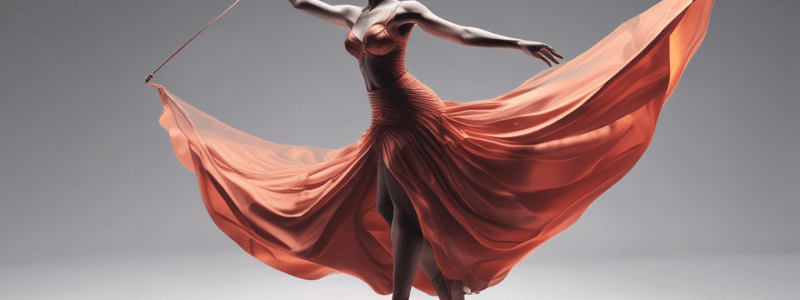Podcast
Questions and Answers
What is essential to have before starting the choreography process?
What is essential to have before starting the choreography process?
- A theme or concept
- A solid understanding of traditional and modern dance styles (correct)
- A choreographed routine
- A dance studio
What is the purpose of choosing a theme or concept?
What is the purpose of choosing a theme or concept?
- To tie everything together in the choreographic piece (correct)
- To create a storyline for the dance
- To select the music
- To decide on a dance style
What characterizes traditional dance styles?
What characterizes traditional dance styles?
- Fluid and abstract movements
- Improvisation
- High-energy movements
- Specific movements, gestures, and rhythms with cultural or regional roots (correct)
What is a key aspect of modern dance?
What is a key aspect of modern dance?
Why is researching traditional dances important?
Why is researching traditional dances important?
What can traditional movements represent in a choreographed piece?
What can traditional movements represent in a choreographed piece?
What should you consider when choosing a theme or concept?
What should you consider when choosing a theme or concept?
What is the ultimate goal of combining traditional and modern elements in a choreographic piece?
What is the ultimate goal of combining traditional and modern elements in a choreographic piece?
Why is it important to understand traditional styles in choreography?
Why is it important to understand traditional styles in choreography?
What is the benefit of studying modern dance techniques?
What is the benefit of studying modern dance techniques?
What is the purpose of creating transitions in choreography?
What is the purpose of creating transitions in choreography?
Why is it important to consider music and costume choices in choreography?
Why is it important to consider music and costume choices in choreography?
What is the importance of rehearsal in preparing for a performance?
What is the importance of rehearsal in preparing for a performance?
What is the purpose of evaluating and reflecting on a choreographic piece?
What is the purpose of evaluating and reflecting on a choreographic piece?
What is the key to successfully blending traditional and modern elements in choreography?
What is the key to successfully blending traditional and modern elements in choreography?
Why is it important to study the works of influential modern choreographers?
Why is it important to study the works of influential modern choreographers?
What is the purpose of refining the details of your choreography?
What is the purpose of refining the details of your choreography?
Why is it important to solicit feedback from dancers, peers, or mentors?
Why is it important to solicit feedback from dancers, peers, or mentors?
What is the main purpose of studying the liturgy in liturgical dance?
What is the main purpose of studying the liturgy in liturgical dance?
Why is it important to maintain a healthy lifestyle during rehearsals?
Why is it important to maintain a healthy lifestyle during rehearsals?
What is the significance of liturgical dance?
What is the significance of liturgical dance?
What is the purpose of incorporating different dance styles and techniques in liturgical dance?
What is the purpose of incorporating different dance styles and techniques in liturgical dance?
Why is it important to focus on dance fundamentals in liturgical dance?
Why is it important to focus on dance fundamentals in liturgical dance?
What is the purpose of seeking spiritual guidance in liturgical dance?
What is the purpose of seeking spiritual guidance in liturgical dance?
What should you do to enhance your dance vocabulary in liturgical dance?
What should you do to enhance your dance vocabulary in liturgical dance?
What is the purpose of developing musicality in liturgical dance?
What is the purpose of developing musicality in liturgical dance?
What is the significance of maintaining a positive mindset during rehearsals?
What is the significance of maintaining a positive mindset during rehearsals?
What is the first step in maximizing your practice sessions?
What is the first step in maximizing your practice sessions?
What is the primary purpose of warming up before a rehearsal?
What is the primary purpose of warming up before a rehearsal?
Why is it important to prioritize self-care activities during rehearsals?
Why is it important to prioritize self-care activities during rehearsals?
What is the benefit of breaking down the choreography or script into smaller sections?
What is the benefit of breaking down the choreography or script into smaller sections?
What is the purpose of recording and reviewing rehearsals?
What is the purpose of recording and reviewing rehearsals?
Why is effective communication important during rehearsals?
Why is effective communication important during rehearsals?
What is the benefit of maintaining a positive mindset during rehearsals?
What is the benefit of maintaining a positive mindset during rehearsals?
Why is it important to be open to receiving feedback during rehearsals?
Why is it important to be open to receiving feedback during rehearsals?
What is the purpose of regular practice and repetition outside of rehearsals?
What is the purpose of regular practice and repetition outside of rehearsals?
What is the result of setting clear goals before a rehearsal?
What is the result of setting clear goals before a rehearsal?
What is the benefit of creating a schedule or timetable during rehearsals?
What is the benefit of creating a schedule or timetable during rehearsals?
What is the primary focus of liturgical dance?
What is the primary focus of liturgical dance?
When selecting costumes for liturgical dance, what should you prioritize?
When selecting costumes for liturgical dance, what should you prioritize?
How should you use props in liturgical dance?
How should you use props in liturgical dance?
What is crucial to focus on during rehearsals for liturgical dance?
What is crucial to focus on during rehearsals for liturgical dance?
How should you adjust your movements in the performance space?
How should you adjust your movements in the performance space?
What is key to engaging with the audience in liturgical dance?
What is key to engaging with the audience in liturgical dance?
What should you remember when performing liturgical dance?
What should you remember when performing liturgical dance?
What is the ultimate goal of liturgical dance?
What is the ultimate goal of liturgical dance?
Flashcards are hidden until you start studying
Study Notes
Developing a Choreographic Piece
- Combining traditional and modern elements can create a dynamic and captivating performance.
- Understanding traditional and modern dance styles is essential for developing a choreographic piece.
- Traditional dance styles have cultural or regional roots and incorporate specific movements, gestures, and rhythms.
- Modern dance styles embrace more fluid and abstract movements, often breaking away from traditional constraints.
Choosing a Theme or Concept
- Choosing a theme or concept is essential to tie everything together in a choreographic piece.
- The theme could be a story, an emotion, a social issue, or any other concept that speaks to you.
- Consider how traditional and modern elements can enhance and support your chosen theme.
Researching Traditional Dances
- Research traditional dances that align with your chosen theme or concept.
- Observe the gestures, footwork, and body language used in traditional dances.
- Understanding the foundation of traditional styles will allow you to integrate them thoughtfully into your choreography.
Analyzing Modern Dance Techniques
- Research the works of influential modern choreographers and study their choreographic language.
- Pay attention to the use of space, dynamics, level changes, and improvisational elements in modern dance techniques.
- Experiment with modern dance techniques to find ways to blend them with traditional elements.
Combining Traditional and Modern Elements
- Identify moments in your choreography where you can juxtapose traditional movements followed by modern movements, or vice versa.
- Experiment with bridging movements that enable a logical progression from one style to another.
- Create smooth and seamless transitions between traditional and modern elements.
Enhancing the Choreography with Music and Costume
- Select music that complements both traditional and modern elements in your piece.
- Consider using traditional music with modern arrangements or remixes to establish a fusion of the two styles.
- Design costumes that blend traditional and contemporary elements, creating a visually cohesive presentation.
Rehearsing and Refining the Choreography
- Practice each section of the choreography separately, paying close attention to the transitions between traditional and modern elements.
- Ensure that the movements flow smoothly and that the overall performance is cohesive.
- Solicit feedback from dancers, peers, or mentors to gain valuable perspectives and make necessary adjustments.
Evaluating and Reflecting
- Evaluate the choreographic piece after the performance, considering both your original intentions and audience response.
- Reflect on the effectiveness of blending traditional and modern elements, and identify areas for improvement.
- Take note of what worked well and what didn't, and use this reflection to inform and inspire future choreographic endeavors.
Rehearsal Techniques and Tips
- Set clear goals for each rehearsal, focusing on specific aspects of the performance.
- Incorporate a warm-up routine to prevent injuries, activate muscles, and prepare for the demands of the performance.
- Manage time effectively, allocating specific time slots for different aspects of the performance.
- Pay attention to detail, breaking down the choreography into smaller sections and focusing on perfecting each element individually.
Effective Communication
- Establish open lines of communication with fellow performers, directors, or choreographers.
- Listen actively, ask questions when needed, and provide constructive feedback.
- Foster a collaborative environment, encouraging a supportive and creative atmosphere.
Recording and Reviewing
- Record rehearsals and performances to identify areas that need improvement.
- Review recordings to identify technical flaws, timing issues, or other aspects that may benefit from refinement.
- Use recordings to objectively evaluate your performance and implement necessary adjustments.
Mindset and Focus
- Maintain a positive mindset and focus during rehearsals, eliminating distractions and creating a conducive environment.
- Adopt strategies like deep breathing exercises or visualization to enhance focus and concentration.
- Prioritize self-care activities, such as stretching, meditation, or engaging in hobbies outside of performance.
Incorporating Feedback
- Be open to receiving feedback and constructive criticism from peers, mentors, or directors.
- Respond positively to feedback, using it as an opportunity to refine your skills and explore new possibilities.
- Demonstrate professionalism and a commitment to continual growth.
Regular Practice and Repetition
- Set aside dedicated practice time outside of rehearsals to reinforce what you have learned.
- Regular practice ensures that the choreography becomes second nature, allowing you to focus on the emotional and artistic aspects of the performance.
- Consistency is key to strengthening muscle memory, improving technique, and refining performances.
Navigating the Challenges of Performing Liturgical Dance
- Liturgical dance is a sacred and reverent act of worship, requiring a deep understanding of its purpose and significance within a religious context.
- Approach liturgical dance with a prayerful attitude, recognizing that you are offering your movements as a form of worship.
- Study the liturgy and familiarize yourself with the specific elements of the religious service or ceremony.
Practical Application and Performance Techniques
- Focus on fundamentals, such as posture, alignment, body awareness, and fluency in movement.
- Develop strength and flexibility through regular exercise and conditioning routines.
- Enhance your dance vocabulary by exploring different styles and techniques.
Musicality and Interpretation
- Develop a keen sense of musicality by listening closely to the music or hymns.
- Extract the inherent message and emotions from the music, allowing them to guide your movements and expressions.
- Use your body, gestures, and facial expressions to convey a story or message through your dance.
Costumes and Props
- Choose costumes that are modest, respectful, and appropriate for the religious context.
- Use props strategically, ensuring they do not overshadow the spiritual intention of the performance.
- Consult with your dance instructor, religious leaders, or costume designers to ensure that your attire complements the liturgical nature of your performance.
Rehearsal and Performance Considerations
- Rehearse with intention, paying attention to details such as timing, spacing, and synchronization with fellow dancers.
- Familiarize yourself with the performance space and its limitations, adjusting your movements and formations accordingly.
- Connect with the audience, establishing eye contact and projecting your emotions outward.
- Embrace imperfection, understanding that the nature of liturgical dance is heartfelt worship rather than flawless execution.
Studying That Suits You
Use AI to generate personalized quizzes and flashcards to suit your learning preferences.




